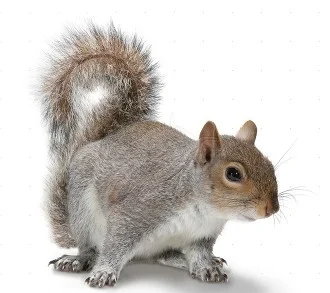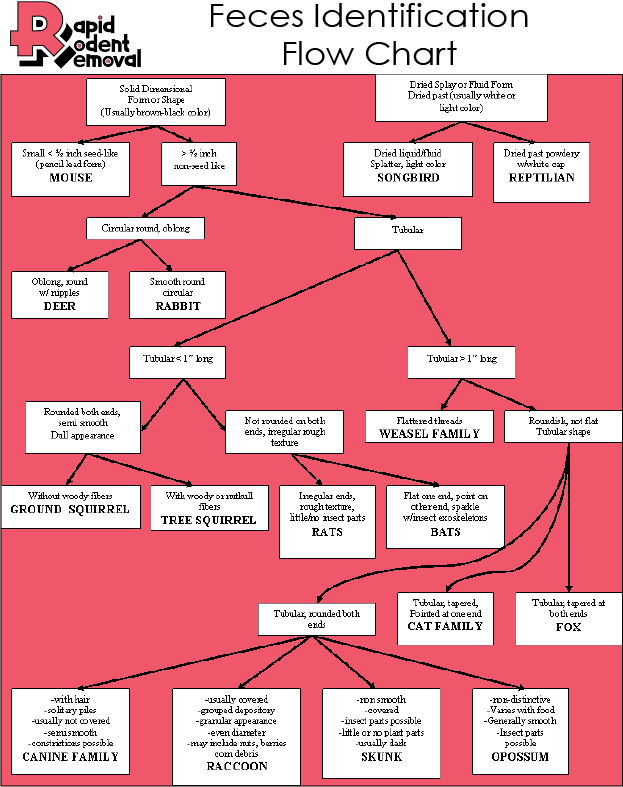What does Squirrel Poop, squirrel feces or squirrel droppings look like ?
Squirrel droppings are typically dark in color, and about the size of a grain of rice, 3/8 inch long and roughly 1/8 inch in diameter. They can be found in clusters, and often have pointed ends. They may have a slight glossy appearance due to the high amount of undigested nuts and seeds. closely resemble rat feces.
Follow along as we discuss the following :
What does Squirrel poop look like
We at rapid Rodent Removal want you to know:
Squirrel Poop Size Pellets are 3/8 inch long and roughly 1/8 inch in diameter
– Shaped like a coffee bean
– Rounded on the edges-Tapered edges
– Shaped like raisins with tapered edges and a bulging middle
– Dries and changes color
– Squirrels often leave piles of several pellets, fewer than a dozen per excretion, though.
– Squirrels often leave feces in the same area over time
– Brown, often with hues of red and other colors including tan and green
Squirrel poop vs Rat poop
Squirrel droppings and rat droppings can have different characteristics in terms of size, shape, color, and smell.
Rat poop is dark in color, elongated, and has pointed ends. It is usually around 1/2 inch long and 1/8 inch in diameter.
Squirrel poop is lighter in color, cylindrical in shape, and has rounded ends. It is usually around 1/2 inch long and 1/4 inch in diameter.
Size: Squirrel droppings are typically slightly larger than rat droppings. Squirrel droppings can measure up to 0.5 inches in length, while rat droppings are usually less than 0.25 inches in length.
Shape: Squirrel droppings have a more oblong shape, while rat droppings are more uniform in shape, typically cylindrical.
Color: Squirrel droppings are dark brown to black in color, while rat droppings are dark brown to black in color as well.
Smell: Squirrel droppings have a mild, earthy smell, while rat droppings have a strong, musty odor.
Content: Squirrel droppings may contain undigested bits of food, such as seeds, while rat droppings are usually smooth and uniform.
It's worth noting that it can be difficult to tell the difference between squirrel and rat droppings just by looking at them, and it's always best to consult with a professional to be certain.
squirrel poop vs rat poop chart
Squirrel Poop, squirrel feces or squirrel droppings Identification
Squirrel droppings are typically dark in color, and about the size of a grain of rice. They can be found in clusters, and often have pointed ends. They may have a slight glossy appearance due to the high amount of undigested nuts and seeds. closely resemble rat feces. Both pests’ poop is dark brown and smooth, but squirrels leave larger, barrel-shaped pellets behind while rats produce small, oblong-shaped droppings with tapered ends. Squirrel feces often appear under trees, around bird feeders, and inside crawl spaces in homes or businesses.
What does rat poop look like ?
What does squirrel poop look like ?
What does raccoon poop look like ?
What does opossum poop look like ?
This is an incredibly important point because you have to know the difference between squirrel feces and rat feces. Squirrels tend to be much more active during the day, so this is one point to take into consideration. In terms of color, squirrel feces tend to be light brown or red and oblong-shaped droppings. Rat droppings however tend to be much darker, being more brown or even black. The diet of these two animals is very different, so look at the shape or the size of the feces too. Squirrel feces are much thicker in the middle and they have rounded edges. Rats on the other hand are much narrower and have a pointed end.
Squirrel Poop, squirrel feces or squirrel droppings are they the same thing ?
Yes, squirrel poop, squirrel feces, and squirrel droppings all refer to the same thing: the excrement produced by squirrels. These droppings can potentially be dangerous as they may contain harmful bacteria and parasites such as Salmonella and E. coli. It is important to avoid contact with squirrel droppings and to clean them up properly using gloves and a disinfectant.
Squirrel droppings can potentially contain a variety of harmful bacteria, viruses, and parasites, including:
Salmonella: This bacteria can cause food poisoning and can lead to symptoms such as fever, diarrhea, and abdominal cramps.
E. coli: This bacteria can also cause food poisoning, and symptoms can include diarrhea, stomach cramps, and vomiting.
Leptospirosis: This bacterial disease can infect both humans and animals and can lead to symptoms such as fever, headache, muscle pain, and jaundice.
Hantavirus: This virus can be contracted through inhalation of dust contaminated with rodent urine or droppings, and can lead to severe respiratory illness and even death in some cases.
Toxoplasmosis: This parasitic infection can be contracted through contact with infected cat feces, or by eating undercooked meat from infected animals. It can cause flu-like symptoms, and can be particularly dangerous for pregnant women as it can cause serious complications for the unborn child.
These are just a few examples of the diseases that can be transmitted by squirrel droppings, and it's important to keep in mind that squirrel droppings should be avoided and handled with care.
Squirrel Poop, squirrel feces or squirrel droppings : how to clean up after
To clean up squirrel droppings, you should take the following steps:
Wear gloves: Squirrel droppings can contain harmful bacteria and parasites, so it's important to protect your hands.
Remove any visible droppings: Use a scoop or shovel to carefully pick up and remove any visible droppings.
Disinfect the area: Once you have removed the droppings, clean the area thoroughly with a disinfectant solution. You can make a solution using a cup of bleach mixed with a gallon of water or use a commercial disinfectant.
Let the area dry: Allow the disinfected area to dry completely before using it again.
Wash your hands: Be sure to wash your hands thoroughly with soap and water after handling the droppings and cleaning the area.
It's also important to note that if you find a large amount of droppings or if you suspect a squirrel has taken up residence in your home, it's best to call a professional for removal as they have the knowledge and equipment to do it safely.
In an attempt to remind customers that Rapid Rodent Removal are also roofers, we have also made a table of contents with all of our information about rats , mouse , squirrels and Roofing , Roof Repair , Roof Replacement (articles & blog) stemming from to all about Rat poop , Mouse poop , Squirrel poop or Raccoon poop in Your Home & or Rats in Attic, to Roofing Contractors to Rodent Control.




